#1813
Text

1st June 1813: The battle between USS Chesapeake and HMS Shannon, by Jenny Morgan (1942-)
83 notes
·
View notes
Photo
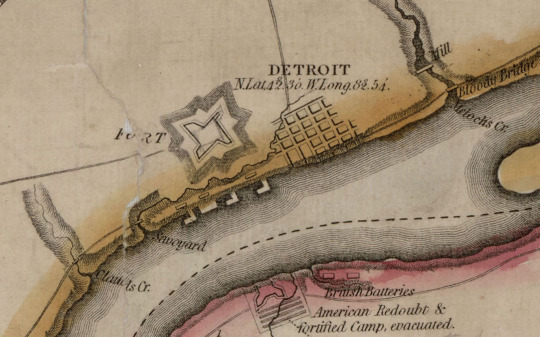
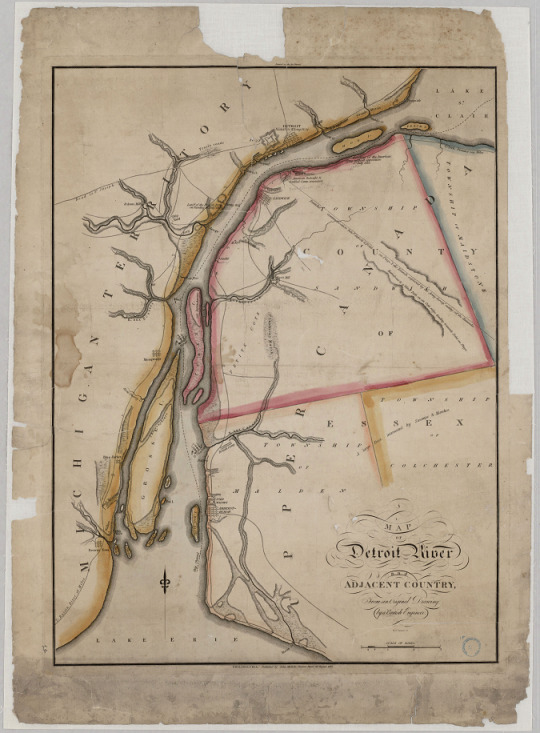
Map of Detroit River and Adjacent Country, August 26, 1813.
Record Group 64: Records of the National Archives and Records Administration
Series: Reference Maps and Drawings
File Unit: Michigan
Image description: Zoomed-in portion of a map of the Detroit River, showing the tiny grid of streets that indicate the town of Detroit, and the fort just to its west. Across the river on the Canadian side of the river are British Batteries, and the American Redoubt and fortified Camp, evacuated.
Image description: Map of the Detroit River from Lake Erie to Lake St. Clair. The Canadian townships and the Michigan Territory side of the river are bordered in different colors. Military fortifications and rivers are labeled, as is a tiny section of streets labeled “Detroit.” What we now know as Belle Isle is labeled “Hog I.”
#archivesgov#August 26#1813#1800s#maps#maps and charts#Detroit#Detroit River#Canada#gotta say Belle Isle is a nicer name
194 notes
·
View notes
Photo

Napoleon's German campaign, 1813.
« Atlas historique de la France », Les Arènes, 2020
by cartesdhistoire
In 1806, Napoleon created the Confederation of the Rhine around Bavaria, Württemberg, Saxony and Baden. It provided support for Napoleonic projects and thus provided tens of thousands of men to the Grande Armée.
68 notes
·
View notes
Text

Journal des Dames et des Modes, Costume Parisien, 20 août 1813, (1334): Par-dessus de Perkale. Robe de Perkale. Manches de Mousseline. Collection of the Rijksmuseum, Netherlands
Standing woman dressed in a 'pardessus' of cotton percale on a dress of cotton percale. Long muslin sleeves. flat shoes with crossed straps and bows (cothurnes). She has a bird on her right hand and a birdcage in her left hand. The print is part of the fashion magazine Journal des Dames et des Modes, published by Pierre de la Mésangère, Paris, 1797-1839.
#Journal des Dames et des Modes#19th century#1810s#1813#on this day#August 20#periodical#fashion#fashion plate#color#description#rijksmuseum#dress#Mésangère
67 notes
·
View notes
Text
Nah cuz why is it always "Wyd" and not "You have bewitched me body and soul, and I love, I love, I love you. And wish from this day forth never to be parted from you."
😫😫😫😫
Oh to be Mrs. Darcy....
#riri posts 💫#OH GOD#me when#when is it my turn#when is it my time to be happy#me and who#like ahhhh#when you know you know#mr darcy#I'm in love#with the character...the actor....the dialogue....the movie...#the book....everything!#pride and predjudice 2005#joe wright#Pride and Prejudice#1813#jane austen#book quotes#bookblr#booklr#film quote#period pieces#Nah cuz there are so many more like—“You must allow me to tell you how ardently I admire and love you.”“I love you. Most ardently.”#also the urge to change my blog theme to Pride and Prejudice like I already have something in mind#should I do it???
21 notes
·
View notes
Note
Hello, dear Josefa ✨
I hope you are doing well!
While Flower and myself were talking about our favourite couples of the napoleonic era, our conversation found its way to the Soults which we would love to group with couples like the Davouts or the Mortiers but can't because of the cheating on our monsieur le maréchal Soult's part.
With that in mind, we wondered: Do we know how madame Soult reacted to the cheating? How did her behaviour change through the first days, weeks, months after finding out? Did it even change?
We are aware that we don't know any details of the actual conversation where the couple discussed this matter but we still wanted to ask!
Thank you for your time and effort! c:
We do not really know, I fear. We do not even know when and how exactly she learned about Soult's little secondary Spanish family. It is quite possible that it did not come completely unexpected anymore, as people in Paris had been gossipping about Soult's alleged infidelities ever since 1810, and in one of his 1811 letters Soult kind of had admitted to a marital misstep.
If I remember correctly, Soult finally was granted permission to leave Spain by mid-February 1813, and could leave at the beginning of March. On his way through Southern France he took the occasion to go see his old mother in Saint-Amans, whom he originally had wanted to visit four years earlier, on his way into Spain. I do not remember (I'm not even sure if it is clear) if Louise and the kids already met with him in Saint-Amans or if they waited for him in Paris but I suspect they went to Saint-Amans and from there back to the capital that Soult reached at the beginning of April. He soon had to leave again, this time with Napoleon to Germany, on the 1813 campaign, and on 12 April he already gave full powers in all matters to his wife so she could handle affairs during his absence.
Did she at this point already know about the full extent of these affairs? It's likely, but we do not have any real clue.
She must have known by late June 1813, however (interestingly, that's the same time when, many miles away, Maria de la Paz Baylèn and her little baby son leave Spain and enter France). We know that because Soult in his letter fom 23 June at least vaguely hints at how hurt Louise must have been by his confessions. He invites her to come to meet with him at Dresden with their children, despite the fact that [...]
you will not be lodged very well, but you will be with me, your sorrows will cease, your cheerfulness will return, and you will be certain that, despite everything that has happened, you have never ceased to be tenderly loved [...]
"Despite everything that has happened" clearly means that by that point, Louise is fully aware of the existence of Maria de la Paz and her baby. And she had taken it badly, as was to be expected. Obviously, she doubted Soult's love for her, and she may have considered taking further steps, or at least that's something Soult feared:
I'm not talking about the other feelings, for nothing could add to their strength other than the step you're taking right now.
(All emphasis by me)
And then he continues to implore her to come and sit down with him and talk it all over.
So, obviously lots of trouble in honeymoon land. From the looks of it, I'd say Louise did not so much react with fury, but rather turned sad and depressed - which probably hit Soult far more. Her fury she apparently kept in stock for one French emperor to be used when she heard that her husband was about to be sent back to Spain again. But that's a different story 😁.
Thank you for the question, and I hope this kind of suffices, as it seems to be all information there is. (All quotes from N. Gotteri, "Le Maréchal Soult", as usual.)
28 notes
·
View notes
Photo

Woolen embroidered cushion, Sweden, 1813
These types of cushions or pads (åkdyna) were created to be used at a wedding, either to cushion the seat during the wedding ceremony or to sit on during the carriage ride to the church. On this cushion, the date and the initials of both the bride and her parents are embroidered between the Adam and Eve motif.
Nordiska Museet, Stockholm (Box 199, NM.0020227) - via historicembroidery
150 notes
·
View notes
Text
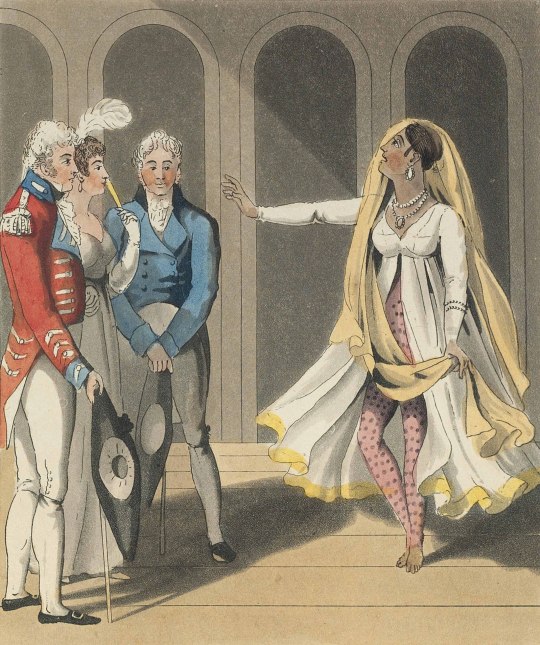
Captain Thomas Williams and Francis Blagdon from "The European in India", illustration by Charles D'Oyly, 1813
#19th century#india#19th c. india#colonialism#mdpillustration#illustration#charles d'oyly#mdpindia#costume illustration#indian costum#1813#1810s
72 notes
·
View notes
Text
Finding the body of Prince Józef
Having finished the series about the last year of Prince Józef's life, it is impossible to ignore the issue of finding his body, especially since many paintings illustrating that event were created in that era and later.

The Allies began searching for the bodies of those killed in the Battle of Leipzig already in the afternoon on the 19th October.

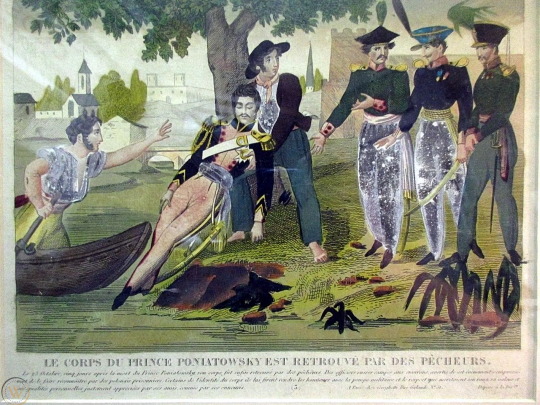
Prince Poniatowski's body was found only on the 24th, a very short distance from the place - about three hundred steps - where he tried to cross the Elster. It was recovered from the river, according to Szymon Askenazy, by Leipzig fishermen Johann Christian Friedrich and Johann Christian Meissner, and their assistants Adam Solten and Beniamin Meissner.


At the time of his death, the prince was wearing a Polish general's uniform, with a Virtuti Militari cross on his chest; some sources even state that being found he still was holding a broadsword in his hand. However, the wig Poniatowski used to wear, together with the artificial sideburns attached to it, slipped off the prince's head and wasn't found together with the body.
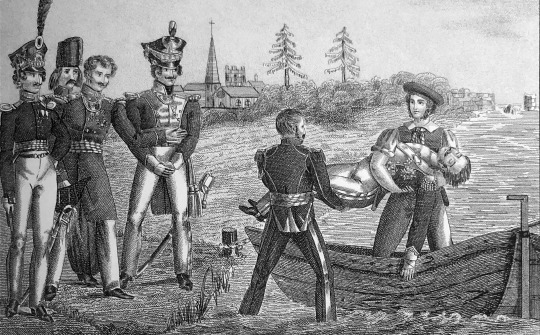

This circumstance made the identification of the body rather difficult. (Though, I had to say, the body’s state wasn’t as bad as it might be expected on the 5th day after death - the cold water kinda preserved it. Antoni Ostrowski even states that prince’ face was serene, smooth and beautiful as in life. But others wrote that there had been a dark spot on his forehead.)
Nevertheless, the Polish generals who had been taken by Allied as prisoners of war - Grabowski, Kamieniecki, Krasiński, Rożniecki and Umiński - recognized in the deceased man his commander...

Czesław Tański, Prince Józef's body recovery from the Elster
One of the images from my collection even shows prince Józef without his wig (though with sideburns, and moustache - about which I am still not sure whether Poniatowski) was wearing it at the time of his death:
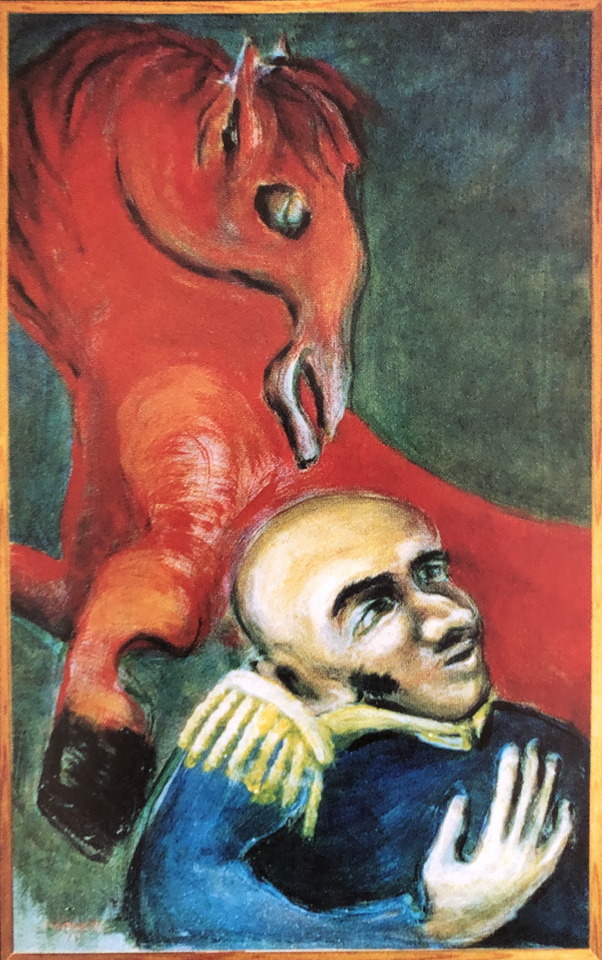
Leszek Woźniak, prince Józef drowning
Having being found, Poniatowski's body was then deposited in the underground vault of the city hall of Leipzig (it was there where the official recognition was made).

Charon, Soldiers carrying the body of Prince Józef
Then it would be buried in the church of St. John (but this is the topic for another post...)
52 notes
·
View notes
Text


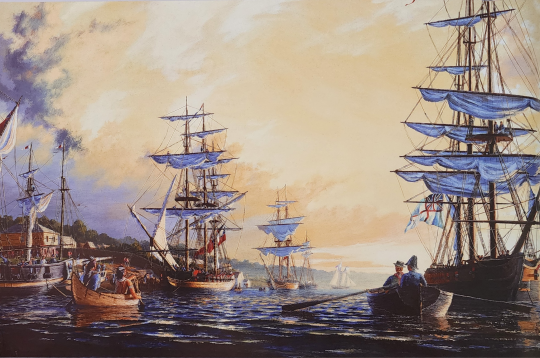
Sunset at Amherstburg Navy Yard, by Peter Rindlisbacher. The flagship HMS Detroit is anchored on the left and the ship-rigged corvette Queen Charlotte is anchored on the right, before the Battle of Lake Erie in 1813.
#war of 1812#age of sail#military history#lake erie#great lakes#1810s#1813#battle of lake erie#peter rindlisbacher#maritime history#naval art#canadian history#upper canada#royal navy#amherstburg#tall ships#hms detroit#provincial marine
19 notes
·
View notes
Text
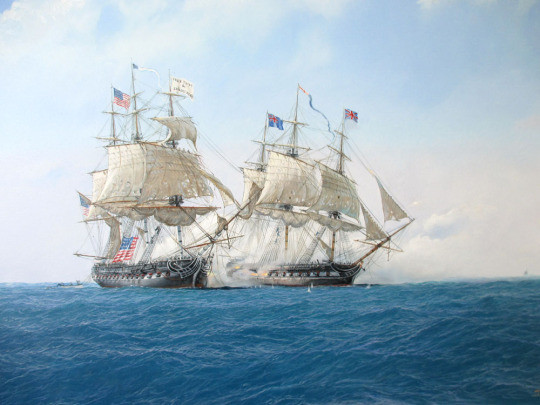
1st June 1813: The battle between USS Chesapeake and HMS Shannon, by Jenny Morgan (1942-)
82 notes
·
View notes
Text
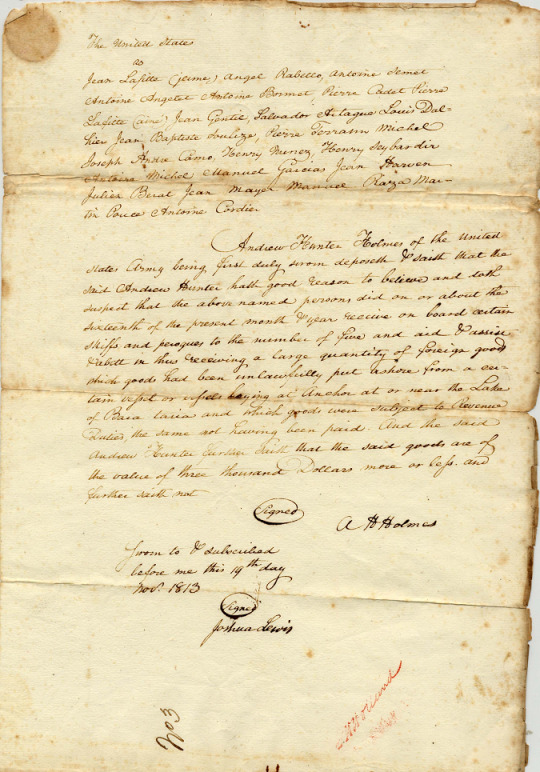
Deposition of Andrew Hunter Holmes filed in case of United States v. Jean Lafitte
Record Group 21: Records of District Courts of the United StatesSeries: Case FilesFile Unit: 573: United States v. Jean Lafitte
The United States vs Jean Lafitte (jeune) Angel Rabello, Antoine Semel, Antoine Angelet Antoine Bormet, Pierre Cadet Pierre Lafitte (aine) Jean Gentie, Salvadore Artagus Louis Dalhier Jean Baptiste oulize, Pierre Terram Michel Joseph Andre Camo, Henry Munez, Henry Saybardir Antoine Michel Manuel Garcias Jean Harven Julien Beral Jean Mayer Manuel Raza Martin Pouce Antoine Cardier
Andrew Hunter Holmes of the United States Army being first duly sworn deposeth & saith that the said Andrew Hunter hath good reason to believe and doth suspect that the above named persons did on or about the sixteenth of the present month & year receive on board certain skiffs and peroques to the number of five and aid & assise & abet in this receiving a large quantity of foreign goods which goods had been unlawfully put ashore from a certain vessel or vessels laying at Anchor at or near the Lake of Baratavia and which goods were subject to Revenue Duties, the same not having been paid. And the said Andrew Hunter further saith that the said goods are of the value of three thousand Dollars more or less and further saith not
Signed
A H Holmes
Sworn to & subscribed before me this 19th day Nov. 1813
Signed
Joshua Lewis
45 notes
·
View notes
Text
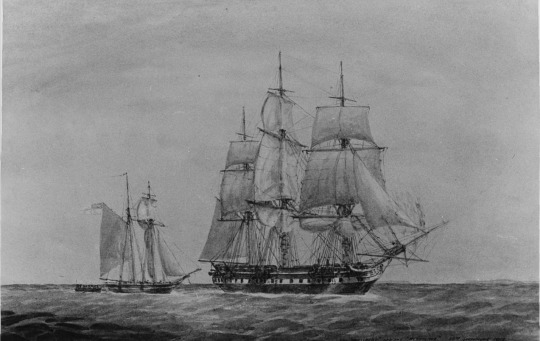
"On September 9, 1813, the United States frigate USS PRESIDENT, Commodore John Rodgers, on his way home after a cruise, when a little to the southward of Nantucket, fell in with the 5-gun British schooner HMS HIGHFLYER, tender to HMS SAN DOMINGO, 74 guns, commanded by Second Lieutenant William Hutchinson. By passing as a British frigate and sending a lieutenant dressed in a British uniform on board her, Commodore Rodgers succeeded in getting the book of private British signals and the stations of the different British men-of-war on the American coast. Taking his measures accordingly he was able, on the same day, to enter unobserved into the harbor of Newport, Rhode Island."
NHHC: USN 903314
#USS President#United States Class#Sailing Ship#Warship#Ship#September#1813#New York Navy Yard#New York City#New York#East Coast#artwork#United States Navy#U.S. Navy#US Navy#USN#Navy#my post
23 notes
·
View notes
Text

Journal des Dames et des Modes, Costume Parisien, 30 juin 1813, (1322): Capote de Perkale. Robe à Schall, en Mousseline doublée. Collection of the Rijksmuseum, Netherlands
Woman with a 'capote' of cotton percale on her head. She wears a 'robe à schall' (gown) with short puffed sleeves of lined muslin decorated with fringes. Further accessories: long gloves, flat shoes with crossed straps and bows. Watering can in the hands. The print is part of the fashion magazine Journal des Dames et des Modes, published by Pierre de la Mésangère, Paris, 1797-1839.
#Journal des Dames et des Modes#19th century#1810s#1813#on this day#June 30#periodical#fashion#fashion plate#color#description#rijksmuseum#dress#Mésangère#june color plates
56 notes
·
View notes
Text
“The only person Napoleon seems to have really wanted to be buried by his side was Duroc.” 
“Since the siege of Toulon in 1793, he had never really left Bonaparte.”
“Napoleon had complete confidence in him; he esteemed the servant and loved the man.”
As Duroc was dying at Bautzen in 1813 after getting hit by a cannon ball, “Napoleon went to his bedside, where the dying man, terribly mutilated, was strong enough to ask him to leave. The Emperor held his hand. As he left, Caulaincourt tells us, Napoleon wept, something no one had ever seen.”
Napoleon returned to the farm where Duroc had died three months later and bought the land on the spot, permitting the farmer to continue to live there. His intention for buying the farm was to erect a monument for Duroc.
It was instructed to say: “Here General Duroc, Duke of Friuli, grand marshal of the palace of Emperor Napoleon, struck by a cannon ball, expired in the arms of his emperor and friend.”
This monument was never built because the Russians soon occupied the region and refused to permit it. Duroc’s remains were moved to Les Invalides in 1847, over 30 years after he died. There, he rests in the same location as Napoleon.
I’m crying reading this
Source: Napoleon and de Gaulle by Patrice Gueniffey
#duroc#general duroc#Géraud Duroc#Napoleon#napoleon bonaparte#19th century#napoleonic era#french empire#first french empire#napoleonic#napoleonic wars#bautzen#battle of bautzen#Napoleon’s marshals#marshal#marshalate#empire#1810s#1813#1800s#french#France#Germany#book#literature#historian#history#text post#sad#Les Invalides
51 notes
·
View notes
Photo

210 years ago, Pride and Prejudice was publish! (28 January 1813) Picture found on: @google #janeausten #janeaustenfan #book #books #prideandprejudice #1813 #novel #novels https://www.instagram.com/p/Cn9amwuIjAN/?igshid=NGJjMDIxMWI=
79 notes
·
View notes